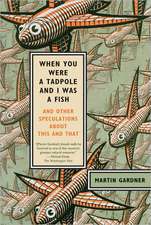Mathematics, Magic and Mystery: Cards, Coins, and Other Magic
Autor Martin Gardneren Limba Engleză Paperback – 31 mai 1956 – vârsta de la 12 ani
| Toate formatele și edițiile | Preț | Express |
|---|---|---|
| Paperback (2) | 53.14 lei 3-4 săpt. | |
| Dover Publications – 31 mai 1956 | 53.14 lei 3-4 săpt. | |
| www.bnpublishing.com – 16 ian 2012 | 83.06 lei 3-5 săpt. |
Preț: 53.14 lei
Preț vechi: 63.42 lei
-16% Nou
10.17€ • 10.62$ • 8.42£
Carte disponibilă
Livrare economică 15-22 martie
Specificații
ISBN-10: 0486203352
Pagini: 208
Dimensiuni: 137 x 203 x 11 mm
Greutate: 0.21 kg
Editura: Dover Publications
Seria Cards, Coins, and Other Magic
Textul de pe ultima copertă
Notă biografică
Martin Gardner: A Remembrance
The worldwide mathematical community was saddened by the death of Martin Gardner on May 22, 2010. Martin was 95 years old when he died, and had written 70 or 80 books during his long lifetime as an author. Martin's first Dover books were published in 1956 and 1957: Mathematics, Magic and Mystery, one of the first popular books on the intellectual excitement of mathematics to reach a wide audience, and Fads and Fallacies in the Name of Science, certainly one of the first popular books to cast a devastatingly skeptical eye on the claims of pseudoscience and the many guises in which the modern world has given rise to it. Both of these pioneering books are still in print with Dover today along with more than a dozen other titles of Martin's books. They run the gamut from his elementary Codes, Ciphers and Secret Writing, which has been enjoyed by generations of younger readers since the 1980s, to the more demanding The New Ambidextrous Universe: Symmetry and Asymmetry from Mirror Reflections to Superstrings, which Dover published in its final revised form in 2005.
To those of us who have been associated with Dover for a long time, however, Martin was more than an author, albeit a remarkably popular and successful one. As a member of the small group of long-time advisors and consultants, which included NYU's Morris Kline in mathematics, Harvard's I. Bernard Cohen in the history of science, and MIT's J. P. Den Hartog in engineering, Martin's advice and editorial suggestions in the formative 1950s helped to define the Dover publishing program and give it the point of view which -- despite many changes, new directions, and the consequences of evolution -- continues to be operative today.
In the Author's Own Words:
"Politicians, real-estate agents, used-car salesmen, and advertising copy-writers are expected to stretch facts in self-serving directions, but scientists who falsify their results are regarded by their peers as committing an inexcusable crime. Yet the sad fact is that the history of science swarms with cases of outright fakery and instances of scientists who unconsciously distorted their work by seeing it through lenses of passionately held beliefs."
"A surprising proportion of mathematicians are accomplished musicians. Is it because music and mathematics share patterns that are beautiful?" -- Martin Gardner
























